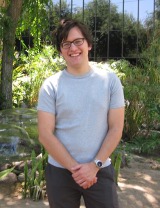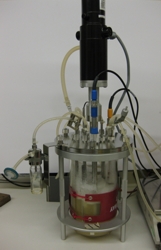|
James Winterburn
Publications
Presentations
|


Biosurfactant production
|
Post-Doctoral Research Associate
Start date: September 2011
Project: Biosurfactant process engineering and a new era of white unit operations
Sponsor: EPSRC Challenging Engineering with Unilever, Croda, Industrial Tomography Systems and Science Made Simple
Email: james.winterburn@manchester.ac.uk
I’ve been a Post-Doctoral Research Associate in the Multiphase Processing Group since September 2011, working on developing efficient biosurfactant production methods. Biosurfactants are naturally occurring amphiphiles with potential for use as alternatives to traditional petrochemical and oleochemical surfactants. The unique properties of biosurfactants, including their biodegradability and tolerance of a wide range of temperature and pH, make their use in a range of novel applications, from stabilising aerated foods to enhanced oil recovery, attractive.
In previous work carried out as part of my PhD an integrated process was designed for in situ recovery of HFBII, a hydrophobin protein, from fermenters. This process was successfully used to remove HFBII from the fermenter during fermentations without antifoam. Uncontrolled foam overflow was minimised and an enriched solution of hydrophobin protein recovered.
The aim of my current research is to apply a unit operations approach to the design of novel biosurfactant production and separation processes. At present I’m applying our previously developed integrated biosurfactant production and foam fractionation process to a new system, using Bacillus subtilis to produce a biosurfactant called surfactin. Ultimately pilot scale trials of our foam fractionation process will be conducted to verify the technique.
My broader research interests in industrial biotechnology encompass the efficient production of a range of natural products, such as biopolymers. There is potential for such production mechanisms to contribute towards reducing our dependence on petrochemicals, assisting the UK’s transition to a low carbon economy
Publications:
Winterburn, JB, Martin, PJ (2012). Foam mitigation and exploitation in biosurfactant production. Biotechnology Letters, 43, 187-195. Winterburn, JB, Russell, AB, Martin, PJ (2011). Integrated recirculating foam fractionation for the continuous recovery of biosurfactant from fermenters.Biochemical Engineering Journal, 54, 132-139.
[download pdf 0.6 MB] Winterburn, JB, Russell, AB, Martin, PJ (2011). Characterisation of HFBII biosurfactant production and foam fractionation with and without antifoaming agents. Applied Microbiology and Biotechnology, 90, 911-920.
[download pdf 0.3 MB] Martin, PJ, Dutton, HM, Winterburn, JB, Baker, S, Russell, AB (2010). Foam fractionation with reflux. Chemical Engineering Science, 65, 3825-3835.
[download pdf 0.9 MB] Winterburn, JB, Martin, PJ (2008). Mechanisms of ultrasound foam interactions. Asia-Pacific Journal of Chemical Engineering, 4, 184-190.
[download pdf - 0.5 MB]
Presentations:
Winterburn, JB, Martin, PJ, Russell, AB. Foam recovery of biosurfactants from fermenters. Presentation given at the AIChE Annual Meeting, October 2011, Minneapolis, USA.
[download pdf - 3.6 MB] Winterburn, JB, Martin, PJ, Russell, AB. Production of biosurfactant by fermentation with integral foam fractionation. Poster presented at the CIKTN Associates Event, March 2009, York, UK. Awarded third prize in poster competition.
[download pdf - 2.9 MB] Winterburn, JB, Martin, PJ. Biosurfactant foam separation. Poster presented at the IChemE Biochemical Engineering Subject Group Young Researchers Meeting, January 2008, London, UK.
[download pdf - 1.1 MB] Winterburn, JB, Baker, S, Martin, PJ. Biosurfactants: Efficient production and applications. Winner of IChemE sponsorship competition to present at the 100th AIChE Annual Meeting, November 2008, Philadelphia, USA.
[download pdf - 0.5 MB]
|



